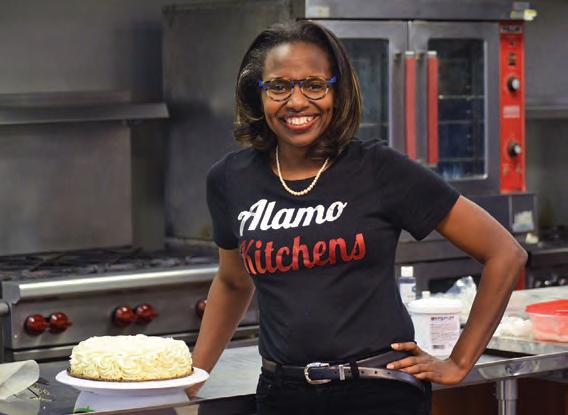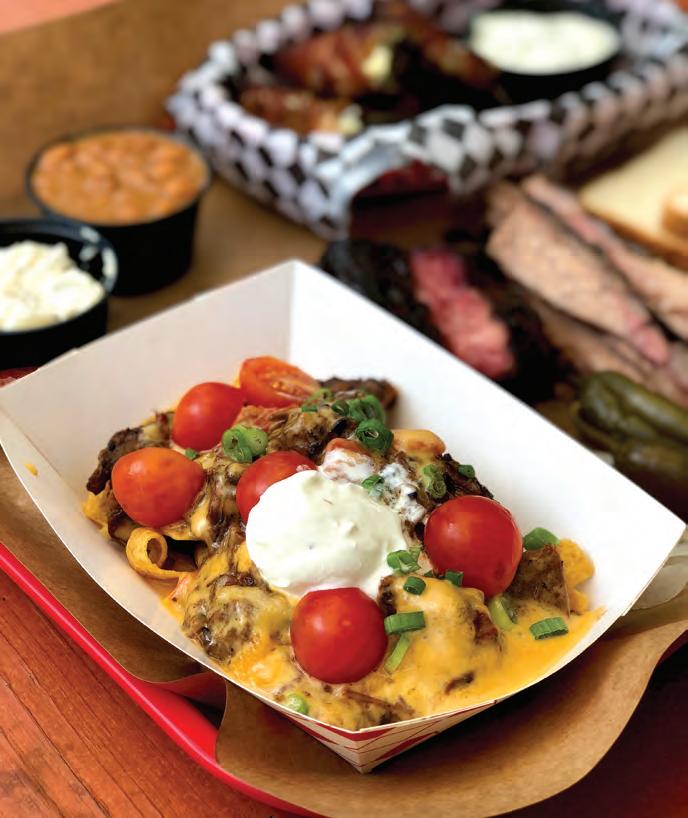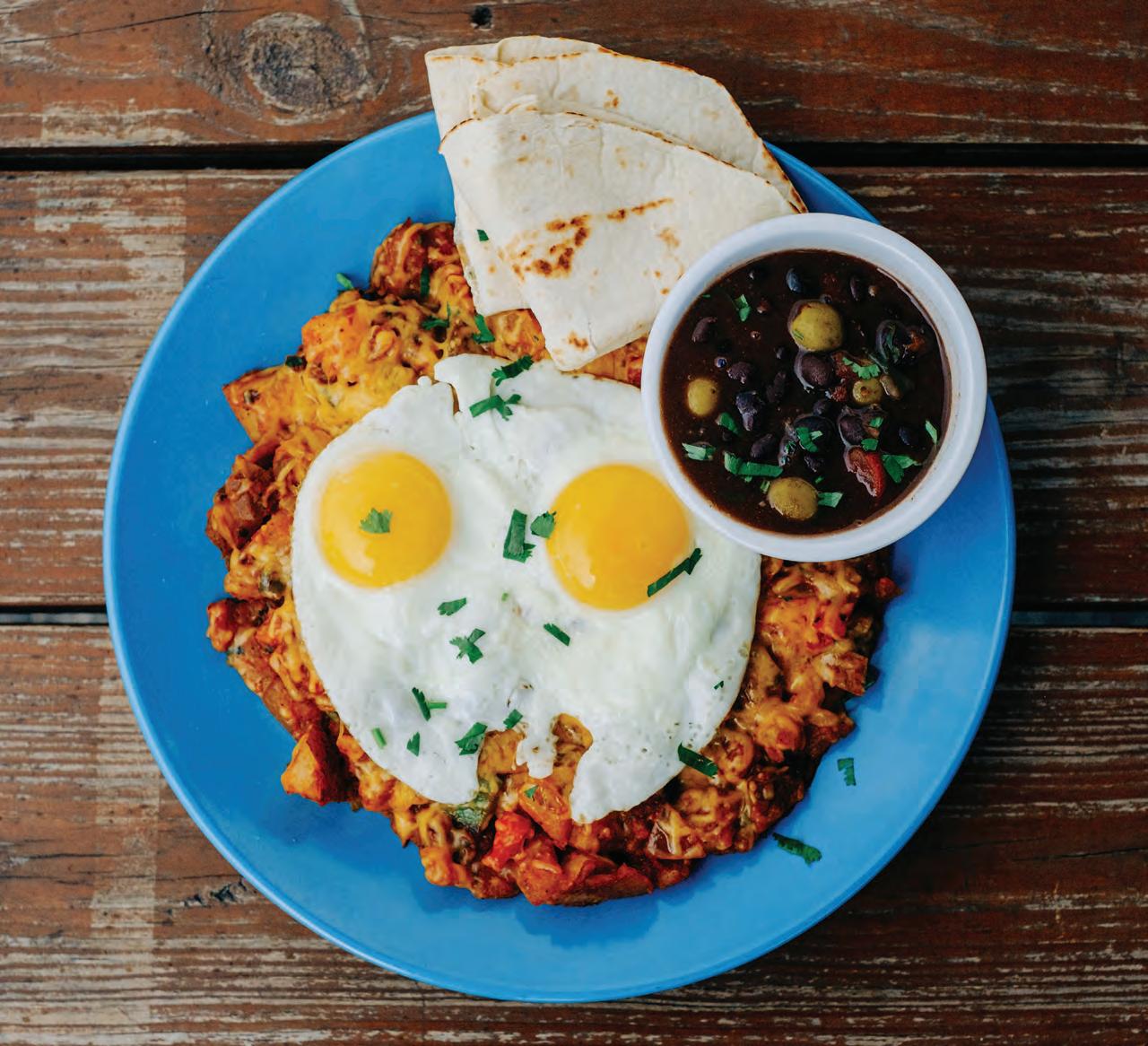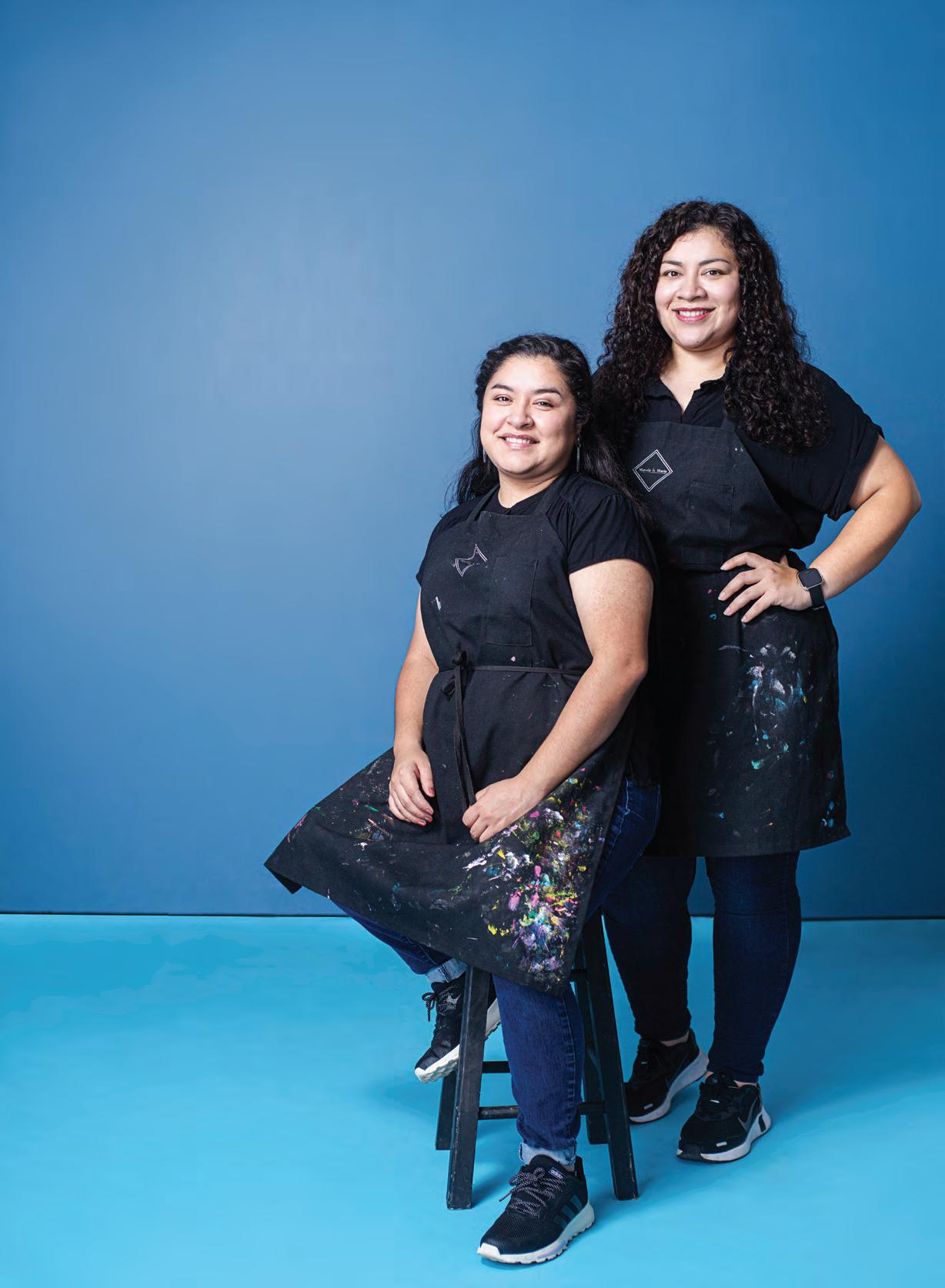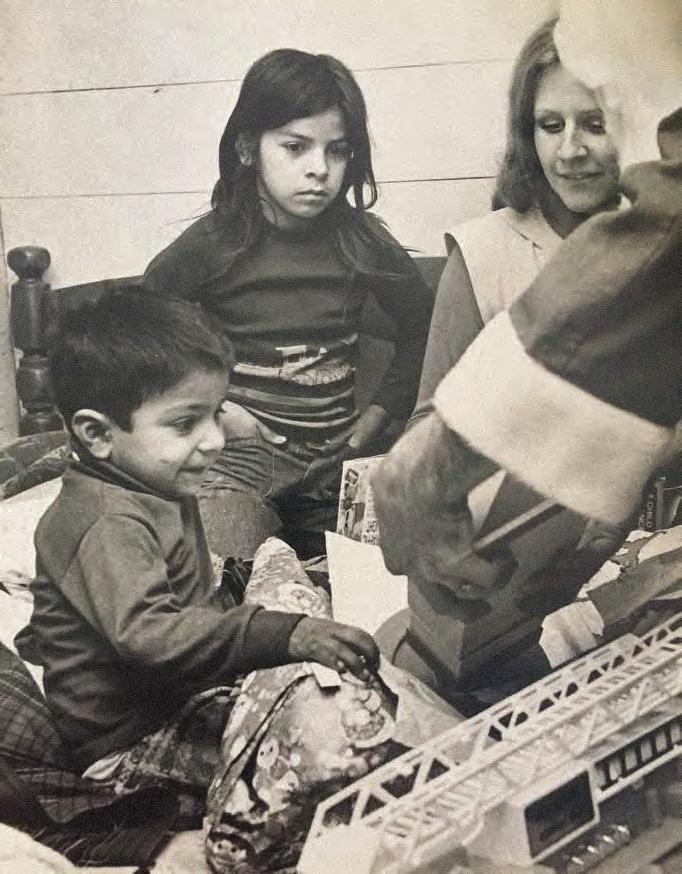
12 minute read
EVENTS
Breeding Normalcy
San Antonio Zoo plans for almost business as usual as it heads into 2021
BY KATHLEEN PETTY
THE SAN ANTONIO ZOO IS PROJECTING IT COULD END
the year with an up to $4 million loss, but Tim Morrow is as positive as a president and CEO can be in the throes of a pandemic.
“We have a cautiously optimistic attitude,” says Morrow. “We’re planning a normal year in 2021, but we know we have to be able to pivot at a moment’s notice.”
Its annual Zoo Lights event, which runs through the end of the year, is the start of normalcy. After a virtual gala and Zoo Boo event that accommodated walking and drive-thru visitors, Zoo Lights is operating like it has in years past, albeit with smaller walking crowds and the presence of face masks and hand sanitizer.
Forced to close its gates to outside visitors from mid-March until after Memorial Day, San Antonio Zoo staff have spent the better part of 2020 getting creative in connecting with guests. Before reopening, they offered animal-themed Easter baskets for pickup and hosted a slew of virtual events, from zookeeper chats to yoga in front of the hippos. In April, a staff member who’d spent time driving the grounds as part of his job suggested launching a drive-through zoo experience, which was the first bit of financial salvation for the nonprofit that was still spending close to half a million dollars a day on animal care and essential staff while closed. (During its closure, 400 of its 700 employees were furloughed while salaried employees, like Morrow, took pay cuts for the year.)
In just its first month, the drive through experience drew more than 20,000 vehicles and through fall had netted over $1 million for the zoo. It’s a concept San Antonio has shared with zoos from Phoenix to Toronto.
While a success, Morrow says it’s not close to enough. In the just over five years he’s been with the zoo, the nonprofit has seen annual revenue grow by nearly $10 million to between $24 million and $26 million. “In past years we have revenue to spend on infrastructure and our mission, but some of that will have to be used to pay off debt in the years to come,” Morrow says. They were projecting $2 million in profit before COVID-19 hit that would have been invested back into the zoo. He adds that in the past, they haven’t done a good enough job explaining that they’re a nonprofit and are not city-funded like many zoos. “We are also fundraising to pay that off,” he says, of any debts. “We need the community’s help to recover from this.”
There have been reasons for hope, including increased foot traffic in the late summer and fall as community spread of COVID-19 slowed in San Antonio and mask wearing and social distancing became the norm. In July, there were days where foot traffic was at 20 percent of a normal summer day.
Events, Morrow says, is part of what helped them grow revenue in recent years so that’s what they’re planning for as they look to bring more visitors back in 2021. After Zoo Lights, guests can expect a full slate of spring break offerings, a Fiesta de los Animales event in April and a special exhibition over the summer. Morrow wants zoo regulars to remain safe, but he says the outdoor setting and compliance with COVID-19 protocols allows for that. “At our core, we are a walk through experience,” Morrow says, explaining the importance of being able to read signage, linger in front of animal habitats and chat with staff. “Our goal is to get back to that 100 percent.”
6 Best Bets
NOV. 27-DEC. 13
THE NUTCRACKER
Ballet San Antonio presents this holiday classic, with choreography by Easton Smith and Haley Henderson Smith, during 12 shows at the Tobin Center. Capacity is limited so reserve tickets early. balletsanantonio.org
NOV. 28 & DEC. 5
DICKENS ON MAIN
Boerne has added an extra Saturday to its annual holiday event to allow for smaller crowds. Watch an ice sculpting battle, walk through holiday villages or see an outdoor theater performance. boernedickensonmain.com
DEC. 5
HOLIDAY ART MARKET
The Tobin Center hosts artisans and makers for this fourth annual outdoor fair. Kids can take a photo with Santa or visit the craft corner. tobincenter.org
DEC. 8-20
THE MUSIC OF A CHARLIE BROWN CHRISTMAS
With Jazz, TX closed for renovations, Doc Watkins and his trio are taking up residence at the Tobin Center’s Carlos Alvarez Studio Theater for intimate holiday concerts featuring tunes from the Charles Schulz classic. tobincenter.org
DEC. 6
GLOBAL CELEBRATIONS
At this month’s touch-free family day at the San Antonio Museum of Art, kids can pick up an art kit to make their own silver ornament or patterned cards. Selfguided gallery games will give families the chance to learn about holiday traditions around the world. samuseum.org
DEC. 28-30
WONDERFUL WINTER HOLIDAY
The Magik Theatre is hosting its “Play in a Day” workshop for kids on break. Children will learn how to act out, dance and sing scenes from some of their favorite shows and movies. magiktheatre.org
4 STORIES YOU MAY HAVE MISSED
Bonus Time / H-E-B announced in October that it would provide employees across Texas with a $500 bonus. The San Antonio–based grocer said in a statement that its success is only thanks to its people and that employees have handled the challenges of 2020 with “grace, compassion, strength and resilience,” so a bonus as they looked ahead to the holidays seemed only fitting.

First Pitch / Four nurses were invited to throw out the ceremonial first pitch when the World Series kicked off in Arlington this fall. San Antonio’s Brittney Burns was among them and was lauded for her care of COVID-19 patients locally and for volunteering to travel to New York to care for COVID-19 patients there earlier in the pandemic.
Sold / After years on the market, Spurs Coach Gregg Popovich’s 9,640-square-foot home in the Dominion sold this fall for $3.1 million—more than a million less than its original asking price in 2018, according to the L.A. Times. Along with an infinity pool, more than 2.5 acres and four bedrooms, the home features a top-of-the-line wine cellar that no doubt housed what’s rumored to be an extensive Popovich collection.
Bears, Oh My! / San Antonio police responded to calls about a bear on trails near Mission Espada this fall, KSAT reported. Police told the callers it was likely an oversized feral hog they’d spotted rather than a bear, but as the officers approached, they found that the sleeping animal was actually a black pot-bellied pig. The creature was large enough to cause a scare but one that officials said was safe to remain near the trail.


The Full Story

Nora López, National Association of Hispanic Journalists president, says representation across mediums and levels is key to equitable coverage
INTERVIEW BY KATHLEEN PETTY
ora López likes to tell students and rookie journalists that N reporting for a daily newspaper is a bit like doing research papers in school—except that now there’s a pop quiz or an assignment due at the end of every day. “It’s very intense because you get thrown into something at the start of the day and you basically do as much research and try to get as many first-hand accounts as you can, all knowing that by 4 or 5 you’re going to have to sit down and write,” she says. Recently elected president of the National Association of Hispanic Journalists (NAHJ), López serves as metro editor at the San Antonio Express-News, the paper where she took her first full-time internship over 30 years ago. The daily grind and the way news is delivered has certainly changed since then, but López, who was born in Mexico, grew up in the Rio Grande Valley and is a naturalized citizen, says the busy news cycle of 2020 has also been a reminder to
FACT FILE
Hometown:
Edinburg
Education:
Pan American University (now University of Texas Rio Grande Valley)
Resume:
San Antonio Express-News, San Antonio Light, Dallas Morning News her of why community journalism matters. With the NAHJ, she’s working to increase the diversity of local newsrooms around the country so that newspapers, news stations and other outlets can tell stories that represent the whole community.
Training Latino journalists is one of your top goals for the NAHJ. In what way?
I’ve been active with NAHJ on and off for close to three decades and this is my second time on the board. Our primary mission has always been to try to help young Latinos get to college, study communications or journalism or broadcast and get their degrees. We want to help get those Latino minority journalists into the pipeline and we’ve done a brilliant job at that. Last year, we gave out some $200,000 in scholarships. But now, we need to start focusing on training folks for those mid-level career management jobs because that’s where diversity is still severely lacking. We need more Latinos in the kinds of positions where we’re making decisions and helping to focus the coverage so that it’s inclusive and reflects the diversity of the communities that we’re covering.
I’ve been fortunate that in San Antonio our newsroom includes a lot of Latinos and I’m really proud of the fact that the majority of our department heads are Latino and that both of our metro columnists are Latino. With reporters, we do not reflect the community right now. We need to do a better job of recruiting.
Talk about why representation in newsrooms is so important.
It’s important because NAHJ firmly believes that you will tell better stories if your newsrooms reflect the community—because you will be able to see stories that might not otherwise get seen. In 2012, for example, there was a Telemundo reporter who moderated a GOP debate and she brought up some really good questions and perspectives that otherwise would not have been talked about. She pointed out that Marco Rubio had made contradictory statements in English and Spanish, which another reporter might not have caught. She also brought attention to the fact that there had been more dangerous people crossing the Canadian border than the southern border, which helped ensure the immigration debate wasn’t focused solely on the south. There was not a single Latino journalist chosen as a moderator this year, and that’s not new and it needs to change.
Are there examples locally where having Latino journalists has impacted coverage?
There are a lot of stories that we’ve been able to do at the Express-News because our newsroom is diverse enough to come up with different ideas.
When a group of immigrants, including several who had died, were found in the back of a
tractor-trailer at a WalMart (in 2017), one of our interns who helped cover the story spoke Spanish. That allowed us to get an interview with one of the relatives who was in the truck. When you speak the same language or have the same background, whether it’s that story or another in our community, it helps to facilitate the conversation and makes people feel more comfortable. I think you get a more authentic voice. I’m proud of the fact that our metro columnists are both Latino. Elaine Ayala is from San Antonio and grew up here, so she brings that unique perspective to her column of knowing San Antonio and its history. Gilbert Garcia is from the Rio Grande Valley and grew up on the border. Both of them bring this context of where they grew up and where they live that I think really elevates the types of columns they write.
Is there anything else in your career that has compared to 2020 in terms of the intensity of news coverage required?
The only other thing I can compare it to was when I was a reporter in the early ’90s at the Dallas Morning News and I was a part of the wave of reporters who was sent to cover the Oklahoma City Bombing. But even that sort of ebbed and flowed and I was able to come back to Dallas. Of course, 9/11 was a story that stayed with all of us for a long time, but I can’t think of anything that has been quite like this.
Along with COVID-19, you all have covered Black Lives Matter protests and the election. What has that been like on reporters?
We’re all learning together right now. I’ve been impressed with how quickly reporters have built and maintained contacts within the Black Lives Matter movement locally since we were relying on them to tell us where and when the protests were and that kind of thing.
COVID-19 being new for everyone makes covering it that much harder. We have a medical reporter who I think is doing a really great job. She was among the first allowed access to a COVID unit locally and she was able to just paint a really vivid picture of what those frontline workers are living through—I think that’s where local journalism is really important because nobody can tell that story the way your city can.
Distrust in the media and the refrain from some that the news is “fake” feels like it has grown in recent years. How do you respond?
There certainly is that feeling out there that people don’t trust the media. The whole big refrain is of course terribly insulting to those of us in the mainstream media who really take our roles of being the community watchdogs seriously. We are making sure that our city and local and state government officials are held accountable.
I’m also hopeful. There was this long-held belief for a while that we—newspapers—messed up with the internet by putting our content out there for free and then the public became accustomed to not paying for it. Newspapers did struggle mightily for well over a decade trying to figure out how to monetize our websites. We struggled with that. But you know what? After the 2016 election, reputable organizations like the New York Times and the Washington Post saw their digital subscriptions grow. We’ve learned people are willing to pay for good, quality journalism. I think now as an industry, we’re seeing a little bit of light at the end of the tunnel in terms of sustaining print journalism.
We have been growing our digital subscriptions tremendously over the last few years and that makes me hopeful and makes me believe that people do still trust us because they’re willing to pay for the coverage. You see it in other ways, too, like at the Texas Tribune, which is a nonprofit model that runs on donations and grants from people who believe in what they do and believe in supporting the news.

